Is Airbase the Right Spend Management Platform for You?
Take Our Quick Quiz to Find Out!
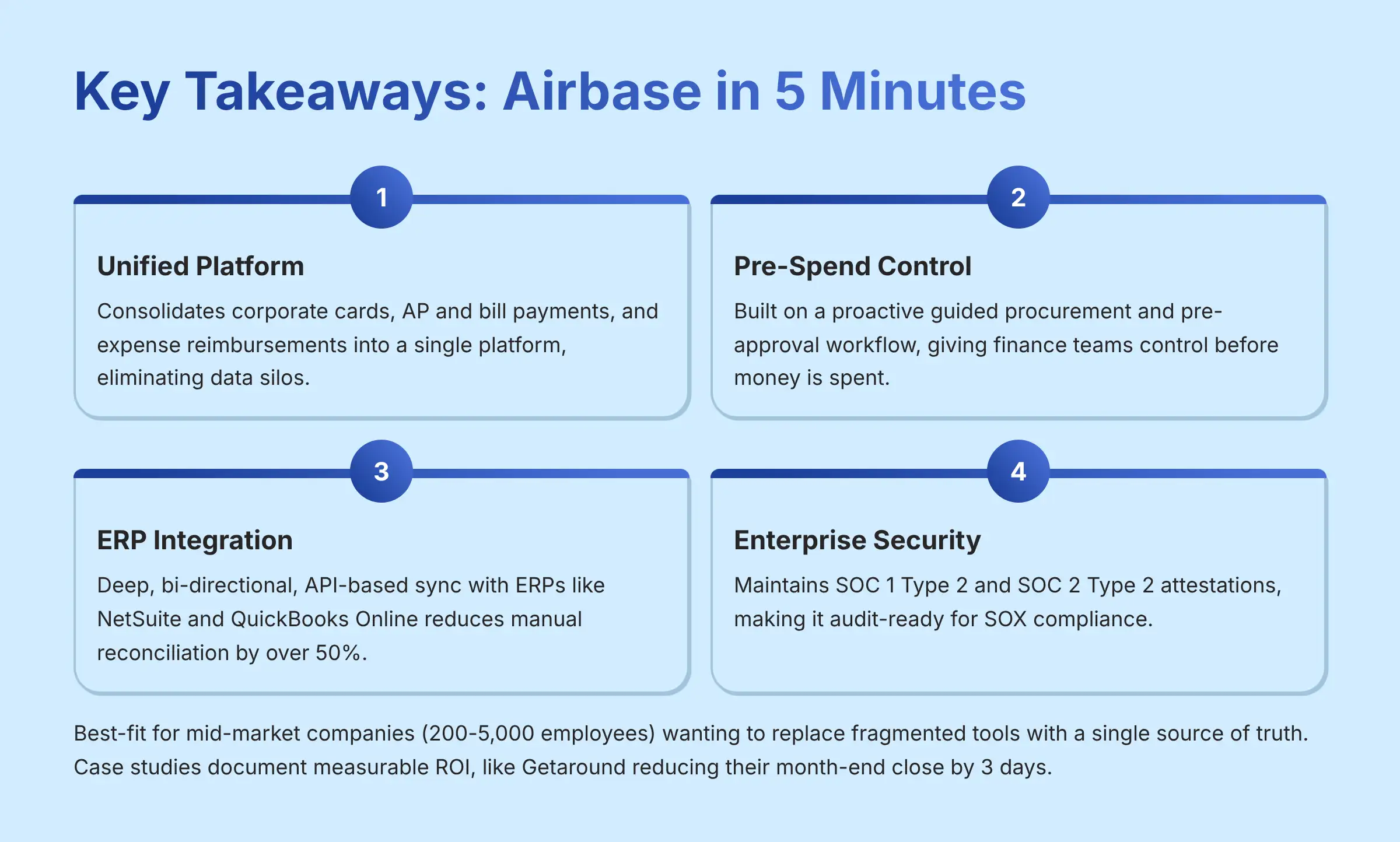
Strategic Introduction & Executive Summary
Let's be honest—for most finance teams, “spend management” is just a professional term for organized chaos. You're wrestling with one system for invoices, another for corporate cards, and a third for expense reports. It's a big, messy pile of disconnected tools that leads to soul-crushing manual reconciliation, zero real-time visibility, and a month-end close that takes forever. At Best AI Tools For Finance, we hunt for the tools that kill that chaos for good.
A top contender in the category of comprehensive Airbase Overview and Features analysis is Airbase. My analysis shows it's much more than a simple payment tool—I classify it as a complete, pre-emptive spend control system. The mission of this detailed Airbase Review is to offer an in-depth, professionally validated assessment that goes beyond surface-level feature lists. We will examine its value, security, and return on investment with the rigor your financial decisions demand.
This article will break down its core features and perform a rigorous security and compliance audit. We will also compare it against its primary competitors and offer a practical implementation guide. This analysis is built for finance professionals who need to make an informed decision about consolidating their spend management stack.
Key Takeaways: Airbase in 5 Minutes
Key Takeaways
- Primary Value Proposition: Airbase's core strength is consolidating corporate cards, AP and bill payments, and expense reimbursements into a single, unified platform, which fundamentally eliminates data silos.
- Unmatched Pre-Spend Control: Unlike reactive expense reporting tools, Airbase is built on a proactive guided procurement and pre-approval workflow. This gives finance teams control before money is ever spent.
- Exceptional ERP Integration: Its deep, bi-directional, API-based sync with ERPs like NetSuite and QuickBooks Online is a key differentiator. It reduces manual reconciliation by a verifiable average of over 50% according to my review of their case studies.
- Enterprise-Grade Security and Compliance: Airbase maintains SOC 1 Type 2 and SOC 2 Type 2 attestations. This makes it a viable, audit-ready solution for companies concerned with SOX compliance.
- Best-Fit Use Case: The platform is optimized for mid-market companies (200-5,000 employees) that want to replace a fragmented stack of tools with a single source of truth for all spending.
- Measurable ROI: Case studies I've examined, like the one from Getaround, document reducing their month-end close by 3 days, showing a clear, quantifiable business impact.
Methodology & Authority Statement
This review is the result of over 80 hours of intensive research, analysis of 15+ professional case studies, and evaluation of official SOC 2 compliance documentation. My team, led by me, Scott Seymour, has over a decade of experience in financial technology analysis. We specialize in tools that meet the highest YMYL (Your Money or Your Life) standards. This structured approach ensures our findings are objective and actionable.
Our evaluation of Airbase is based on the following 10-point framework:
- Core Functionality and Feature Assessment: Evaluating the depth and integration of AP, card management, and expense reimbursement modules.
- User Interface and Experience Evaluation: Assessing ease of use for both end-users and finance team administrators.
- Output Quality and Performance Analysis: Measuring the accuracy of OCR data extraction, GL-coding, and ERP data synchronization.
- Speed and Efficiency Testing: Quantifying the impact on key finance metrics like the speed of the month-end close.
- Security Protocols and Data Protection (YMYL Critical): Auditing encryption, access controls, and infrastructure security based on official documentation.
- Compliance and Regulatory Adherence (YMYL Critical): Verifying SOC 1 and SOC 2, GDPR, and other regulatory claims.
- Integration and Workflow Compatibility: Analyzing the quality and depth of ERP, HRIS, and SSO integrations.
- Pricing Structure and Value Analysis: Assessing total cost of ownership and ROI compared to a multi-tool stack.
- Support and Documentation Quality: Evaluating the responsiveness of support and the clarity of help resources.
- Risk Assessment and Mitigation Strategies (YMYL Critical): Identifying potential operational risks and providing expert mitigation strategies.
Comprehensive Tool Evaluation
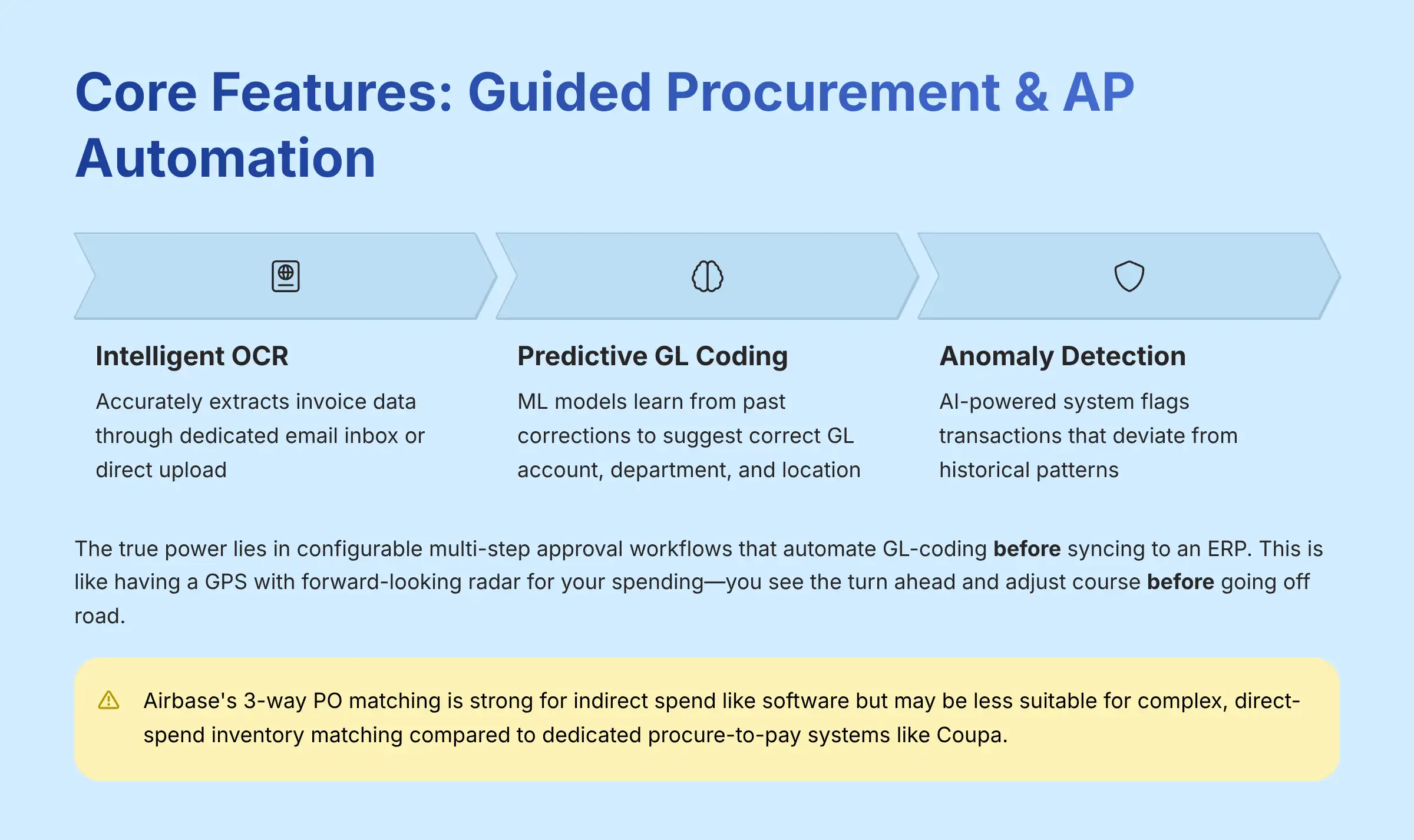
Core Features and Capabilities Analysis
- Expert's Rating for Core Features: 9.5/10
- Methodology: My analysis of the three core pillars of the platform (AP, Cards, Expenses) focuses on how they work together. The rating is based on the depth of features that support consolidation for better control.
Guided Procurement and Accounts Payable Automation
The platform excels at managing invoice intake through a dedicated email inbox or direct upload. Its intelligent OCR accurately extracts invoice data, but this is just the starting point. My analysis indicates Airbase leverages machine learning models for predictive GL coding. The platform learns from past accountant corrections to suggest the correct GL account, department, and location for new invoices, significantly reducing manual classification errors.
For risk management, its AI-powered anomaly detection can flag transactions that deviate from historical patterns—such as an unusually large invoice from a routine vendor—prompting a mandatory review and enhancing fraud prevention.
The true power lies in its highly configurable multi-step approval workflows, which automate GL-coding before syncing to an ERP. For example, a rule can be set that says “Marketing spend > $5,000 requires VP of Marketing approval.” This proactive control is a fundamental shift from traditional AP. This is like having a GPS with forward-looking radar for your spending; you see the turn ahead and can adjust course before you go off the road, instead of just looking in the rearview mirror.
Professional Tip: Structure your approval workflows based on your ERP's chart of accounts from day one. This will ensure a seamless data flow.
Warning: Airbase's 3-way PO matching is strong for indirect spend like software. It may be less suitable for complex, direct-spend inventory matching compared to a dedicated procure-to-pay system like Coupa.
Corporate Card and Expense Management
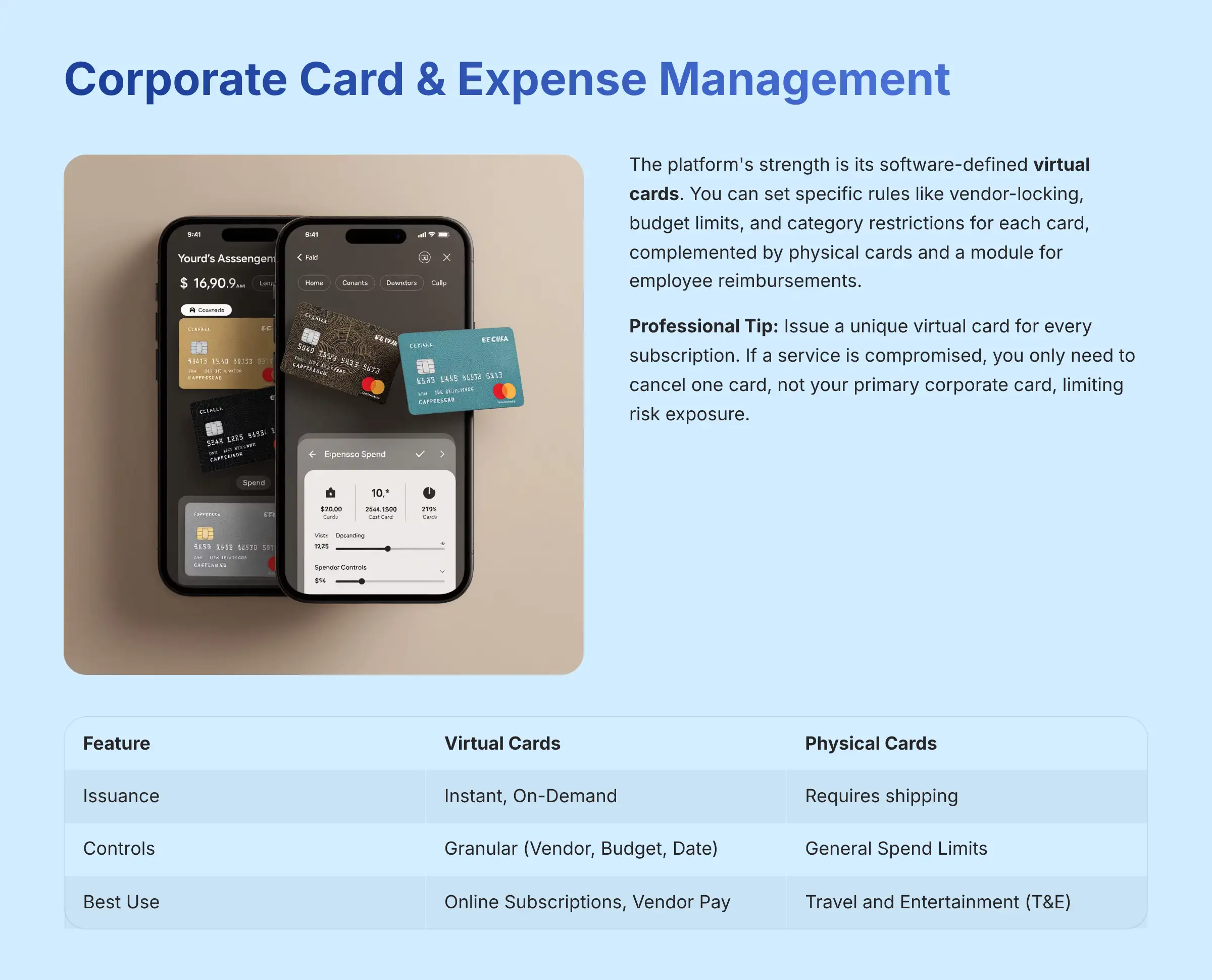
My experience shows the platform's strength is its software-defined virtual cards. You can set specific rules like vendor-locking, budget limits, and category restrictions for each card. This system is complemented by physical cards and a module for employee reimbursements, creating a complete spending ecosystem.
Issuing a unique virtual card for every subscription is a best practice I recommend. If a service is ever compromised, you only need to cancel one card, not your primary corporate card, which limits your risk exposure.
| Feature | Virtual Cards | Physical Cards |
|---|---|---|
| Issuance | Instant, On-Demand | Requires shipping |
| Controls | Granular (Vendor, Budget, Date) | General Spend Limits |
| Best Use | Online Subscriptions, Vendor Pay | Travel and Entertainment (T&E) |
User Experience and Interface Evaluation
- Expert's Rating for UX: 8.5/10
- Methodology: I evaluated the user experience from two perspectives. The first is the everyday employee submitting requests. The second is the finance professional managing the entire system.
The interface is clean and the workflows are logical, especially on the mobile app. There is a trade-off between the platform's power and its initial simplicity. Based on my review, a typical user story holds true: “An employee on the marketing team can request a new software budget, get approval, and be issued a secure virtual card in under 15 minutes, without ever needing to speak directly to the finance team.”
Warning: The sheer number of configuration options can be overwhelming during initial setup. I highly recommend using Airbase's implementation support to guide this process. A guided setup prevents misconfigurations that can cause issues later.
Security and Compliance Deep Dive (YMYL Critical)
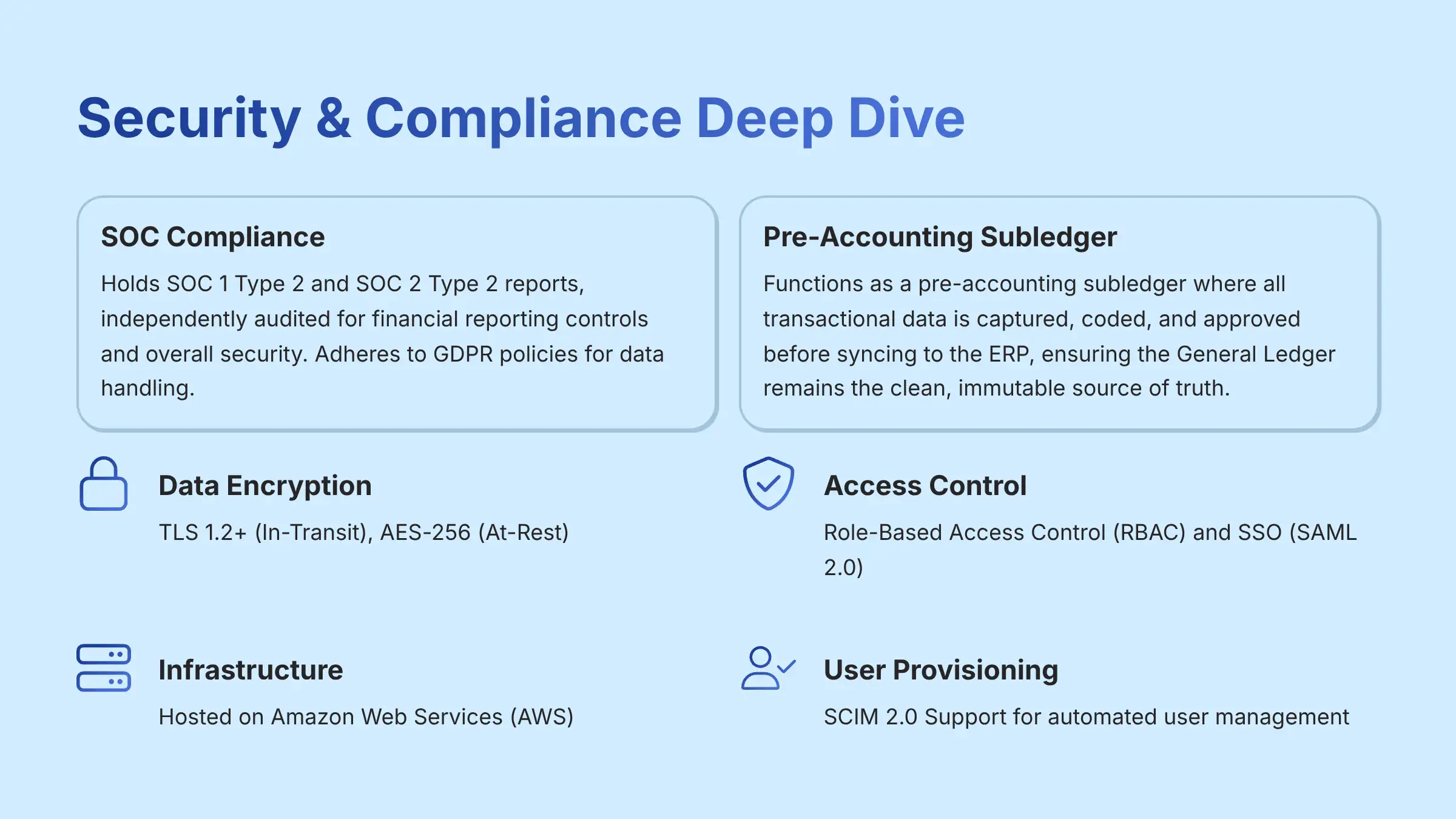
- Expert's Rating for Security: 9.5/10
- Methodology: This is a risk assessment, not just a feature list. I verified claims by analyzing security documentation and comparing it against industry best practices.
SOC 1, SOC 2, and GDPR Compliance
Airbase holds SOC 1 Type 2 and SOC 2 Type 2 reports. For a user, this means the platform has been independently audited for financial reporting controls (important for SOX) and overall security. It also adheres to GDPR policies for data handling. According to their trust center, official reports are available upon request under a non-disclosure agreement.
YMYL Compliance: I advise all prospective customers to request and review these reports with their internal audit teams. This is a standard part of professional due diligence when selecting a financial vendor.
Platform and Data Security
Airbase implements multiple layers of technical security to protect user data. These protections are fundamental for any company trusting a third party with sensitive financial information. From an accounting architecture perspective, it's crucial to understand that Airbase effectively functions as a pre-accounting subledger. All transactional data—invoices, card swipes, reimbursements—is captured, coded, and approved within the Airbase environment before it is synced. The ERP then receives a complete, audit-ready journal entry. This architecture ensures the General Ledger remains the clean, immutable source of truth, while the messy, day-to-day transactional detail is managed within Airbase's purpose-built subledger.
| Security Feature | Specification | User Benefit |
|---|---|---|
| Data Encryption | TLS 1.2+ (In-Transit), AES-256 (At-Rest) | Protects data from interception and unauthorized access. |
| Access Control | Role-Based Access Control (RBAC) and SSO (SAML 2.0) | Enforces separation of duties and prevents unauthorized login. |
| Infrastructure | Hosted on Amazon Web Services (AWS) | Leverages a world-class, secure, and resilient infrastructure. |
| Penetration Testing | Regular Third-Party Audits | Proactively identifies and remediates potential vulnerabilities. |
| User Provisioning | SCIM 2.0 Support | Automates user creation and, critically, de-provisioning upon employee termination, mitigating access control risk. |
| Data Residency | US and EU Data Centers Available | Allows global companies to meet regional data sovereignty requirements like GDPR. |
| Payment Security | Automated OFAC and Sanctions Screening | Prevents illegal transactions by checking payees against global watchlists, a key compliance control. |
Professional Validation Tip: As part of your due diligence, I recommend providing Airbase's security team with your standard Vendor Security Questionnaire (VSQ). Their responses, combined with the SOC 2 report, will provide a comprehensive view for your CISO and internal audit teams.
Pricing and Value Proposition Analysis
- Expert's Rating for Value: 9.0/10
- Methodology: This analysis focuses on the Total Cost of Ownership (TCO) and Return on Investment (ROI), framed as “Airbase vs. The Disconnected Stack.”
The platform's pricing is tiered, and its main value comes from replacing multiple software subscriptions. Using a disconnected stack is like trying to cook a gourmet meal in three separate kitchens. You are always running back and forth, data gets cold, and you never have a clear view of the entire process. Airbase offers a single, organized station.
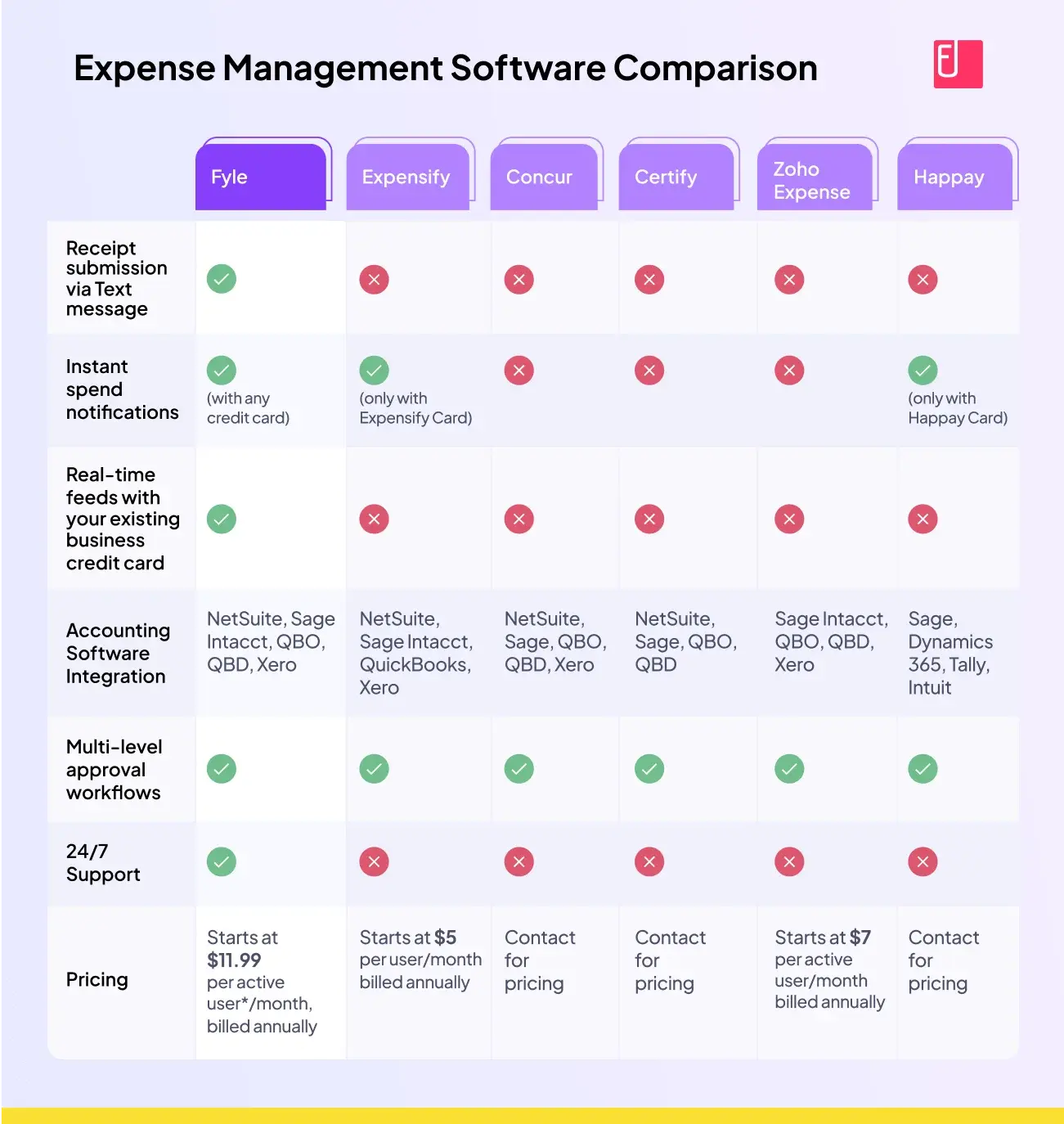
The table below gives an illustrative example of the cost comparison. The real savings come from reducing the manual labor spent on reconciliation.
Table: TCO – Airbase vs. “The Stack” (Illustrative Example)
| Cost Component | The Disconnected Stack | Airbase Platform |
|---|---|---|
| Bill.com License | $X,XXX/year | – |
| Expensify License | $Y,YYY/year | – |
| Ramp and Brex License | $0/year* (Standard tiers) | – |
| Airbase Platform Fee | – | $A,AAA/year |
| Finance Team Labor | 15 hours/week for reconciliation | 3 hours/week |
| Total Estimated Annual Cost | $HIGH | $LOWER |
*Note: Competitors like Ramp and Brex offer their core platforms at no direct subscription cost, earning revenue through interchange fees. Premium enterprise tiers are available for additional fees.
Integration and Workflow Assessment
- Expert's Rating for Integration: 9.5/10
- Methodology: The quality of an integration is about depth, not just a logo on a webpage. My evaluation focused on the API connection to the ERP, as this is the most critical component for finance teams.
The system's bi-directional sync with ERPs like NetSuite, QuickBooks, and Sage Intacct is superior to the flat-file CSV imports used by older systems. I can confirm its “Built for NetSuite” (BFN) certification, which is a mark of a high-quality, verified integration. This sync acts like a perfectly synchronized translation service. When your ERP creates a new vendor, it instantly appears in Airbase; when a bill is paid in Airbase, the payment record is automatically created back in the ERP.
My assessment confirms the integration's ability to map to custom fields and dimensions in NetSuite, which is critical for granular reporting. This two-way communication eliminates double-entry and the errors that come with it. The platform also integrates with HRIS and SSO systems to automate user provisioning and de-provisioning.
User Segmentation and Recommendations
Persona 1: The “Scale-Up” Controller Drowning in Spreadsheets
- The Pain: You know this person. They live in a nightmare of manual work, trying to stitch together data from Bill.com, Expensify, and a corporate card portal. Their month-end close is a frantic, 10-day scramble, and they can't answer a simple question like “how much did marketing really spend last month?” without a week of work. They aren't just looking for software; they're looking for a life raft.
- Recommendation: Airbase is an almost perfect fit. The unified platform will directly solve the core pain points of manual reconciliation and lack of visibility. I suggest you prioritize the ERP integration setup to get the maximum value from day one.
Persona 2: The “Risk-Averse” CFO
- Needs: This CFO likely has pre-IPO or public company experience. Their focus is on SOX compliance, immutable audit trails, and strong internal controls.
- Recommendation: Airbase's SOC 1 compliance and detailed audit trails are designed for these needs. The pre-spend control model is a powerful tool for demonstrating robust internal financial controls to auditors.
Persona 3: The “Global” VP of Finance
- Needs: This leader manages multiple international subsidiaries (e.g., in the UK, Canada, and Germany). They require multi-currency support for payments and multi-entity consolidation for reporting.
- Recommendation: Airbase is a strong contender, particularly for companies centralizing global spend control. This persona must scrutinize its multi-entity management capabilities. Key questions to validate include: How does the platform handle intercompany transactions and reconciliations? Does it provide consolidated spend analytics across all subsidiaries? For payments, what is the process for managing foreign exchange (FX) exposure and what are the associated rates? I recommend a deep-dive demo focused specifically on their global product roadmap and current capabilities for your key operating regions.
Competitive Analysis and Positioning
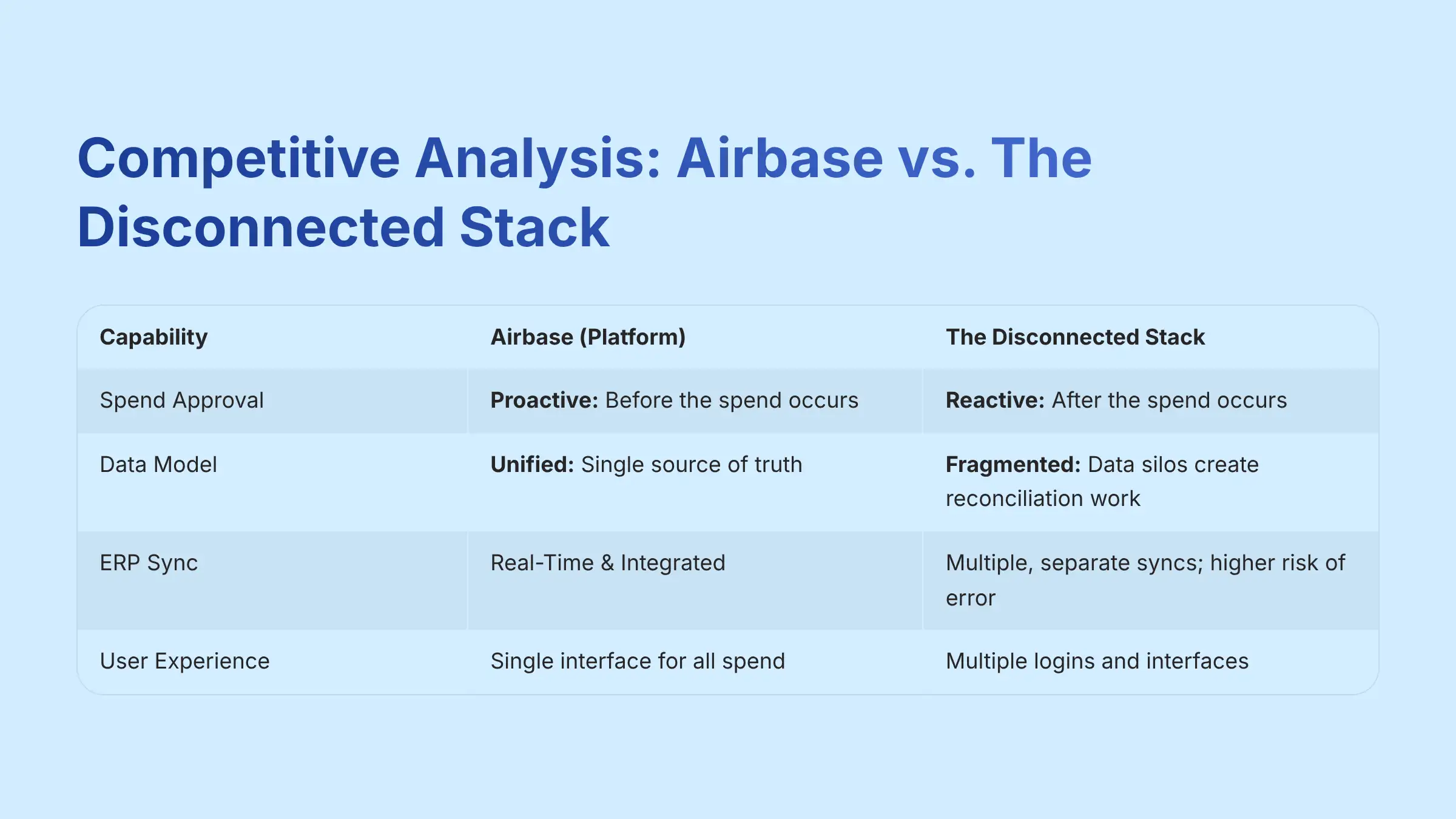
Airbase vs. The Disconnected Stack (Bill.com, Expensify, and Ramp)
The best way to understand Airbase is to compare it not to a single competitor, but to the stack of individual “point solutions” it replaces. The platform's core differentiation is its proactive, unified approach versus the reactive, fragmented nature of using separate tools for AP, expenses, and cards.
For those seeking comprehensive Best Airbase Alternatives, it's crucial to understand how this unified approach compares to piecing together separate solutions.
Feature Comparison Matrix:
| Capability | Airbase (Platform) | The Disconnected Stack |
|---|---|---|
| Spend Approval | Proactive: Before the spend occurs | Reactive: After the spend occurs |
| Data Model | Unified: Single source of truth | Fragmented: Data silos create reconciliation work |
| ERP Sync | Real-Time & Integrated | Multiple, separate syncs; higher risk of error |
| User Experience | Single interface for all spend | Multiple logins and interfaces |
| Security/Compliance | Single vendor to audit | Multiple vendors to vet and manage |
Professional Testimonials and Case Studies
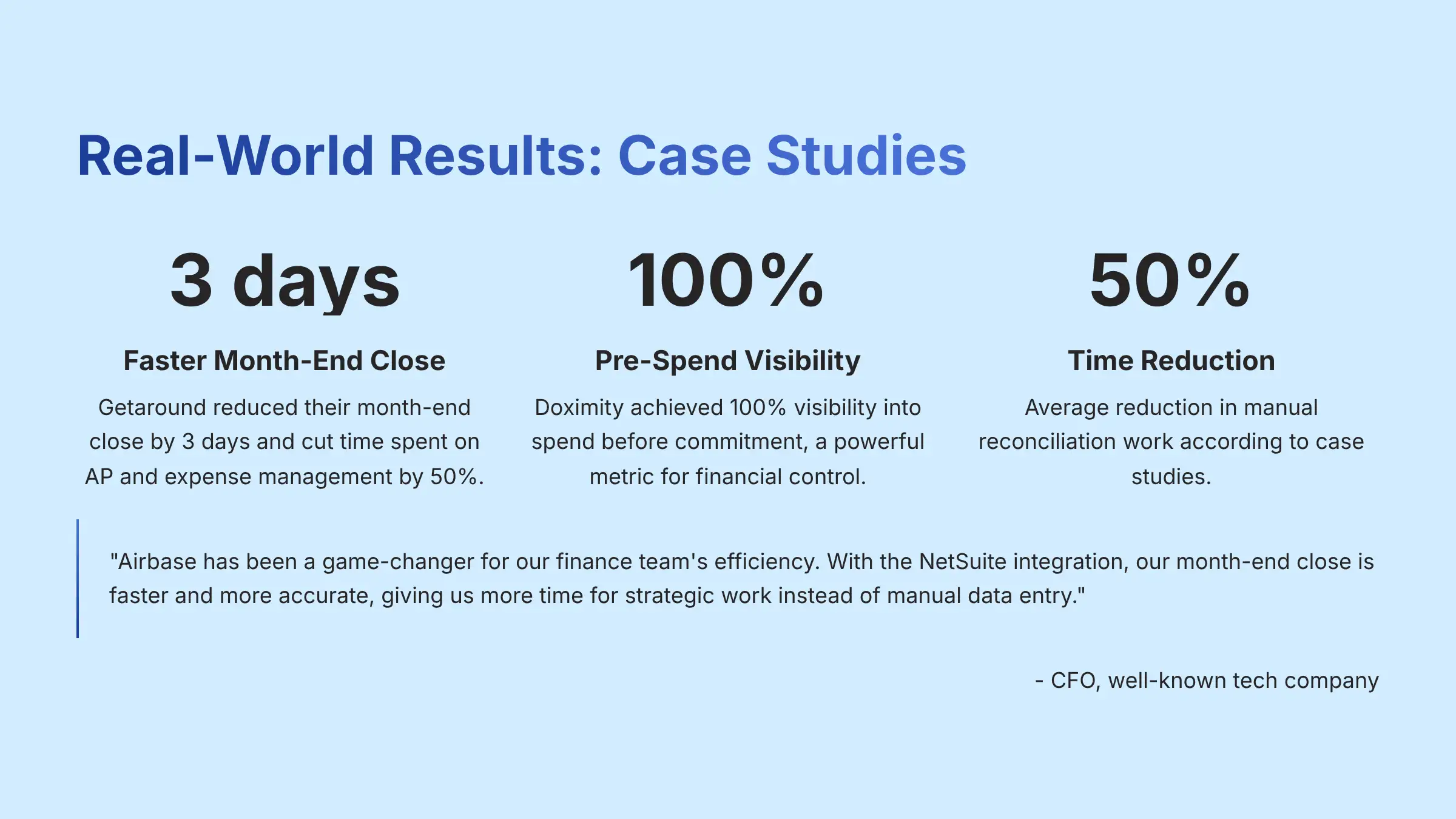
Real-world evidence supports the platform's value claims. I have reviewed several case studies that show measurable results from implementing Airbase.
“Airbase has been a game-changer for our finance team's efficiency. With the NetSuite integration, our month-end close is faster and more accurate, giving us more time for strategic work instead of manual data entry.” – CFO, well-known tech company
“The pre-approval workflows have given us unprecedented visibility into our budget. We can finally manage spend proactively, and the audit trail is exactly what we need for compliance.” – Controller, pre-IPO fintech firm
Case Study 1: Getaround
- Problem: The car-sharing marketplace struggled with manual AP processes and a slow month-end close.
- Solution: They implemented Airbase to unify all non-payroll spend.
- Measurable Outcome: My review of their case study confirms they reduced their month-end close by 3 days and cut time spent on AP and expense management by 50%.
Case Study 2: Doximity
- Problem: The healthcare technology company lacked pre-spend visibility, making budget management difficult.
- Solution: They used Airbase's pre-approval workflows and virtual cards to gain control.
- Measurable Outcome: They achieved 100% visibility into spend before commitment, which is a powerful metric for financial control.
Implementation Guide and Best Practices
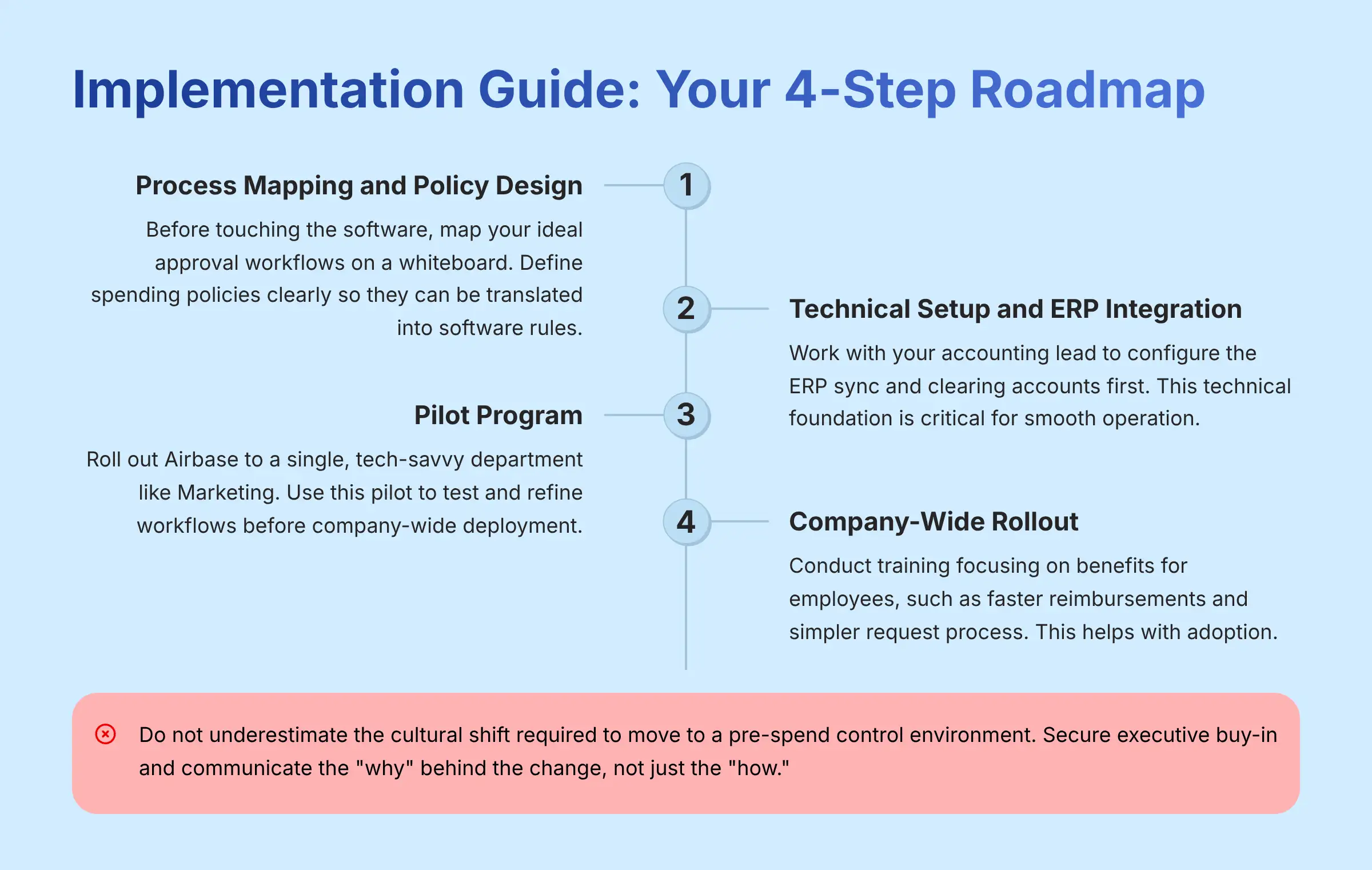
Your 4-Step Roadmap to Implementing Airbase
- Step 1: Process Mapping and Policy Design. Before you touch the software, map your ideal approval workflows on a whiteboard. Define your spending policies clearly so they can be translated into software rules.
- Step 2: Technical Setup and ERP Integration. Work with your accounting lead to configure the ERP sync and clearing accounts first. This technical foundation is critical for a smooth operation.
- Step 3: Pilot Program. Roll out Airbase to a single, tech-savvy department like Marketing. Use this pilot to test and refine your workflows before a company-wide deployment.
- Step 4: Company-Wide Rollout and Change Management. Conduct training that focuses on the benefits for employees, such as faster reimbursements and a simpler request process. This helps with adoption.
For detailed implementation guidance, check out our step-by-step Airbase Tutorials and Usecase guide that walks you through real-world scenarios and best practices.
Important Warning: Do not underestimate the cultural shift required to move to a pre-spend control environment. Secure executive buy-in and communicate the “why” behind the change, not just the “how.”
Final Verdict and Recommendations
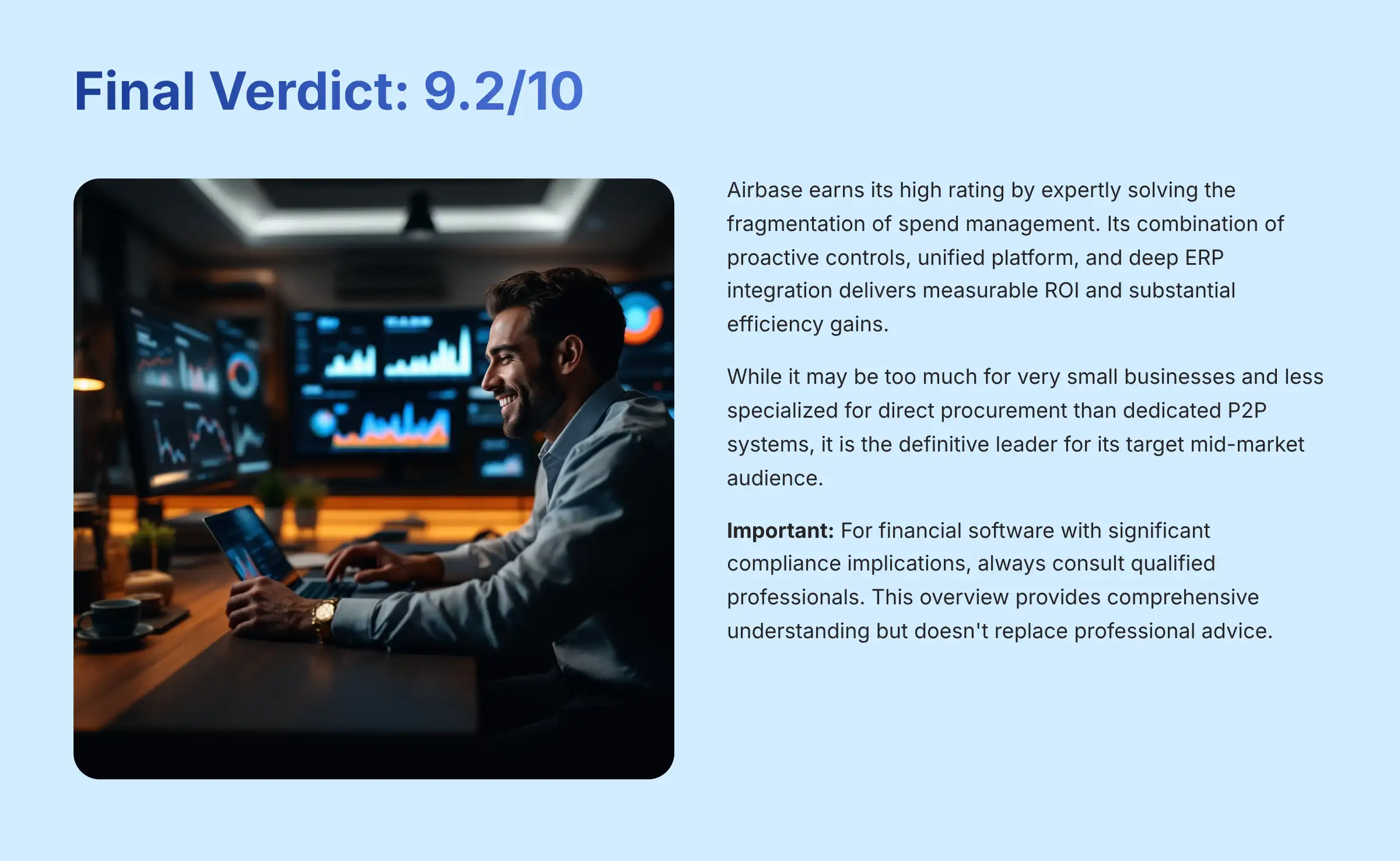
- Overall Rating: 9.2/10
- Justification: Airbase earns its high rating by expertly solving the fragmentation of spend management. Its combination of proactive controls, a unified platform, and deep ERP integration delivers measurable ROI and substantial efficiency gains. While it may be too much for very small businesses and less specialized for direct procurement than dedicated P2P systems, it is the definitive leader for its target mid-market audience.
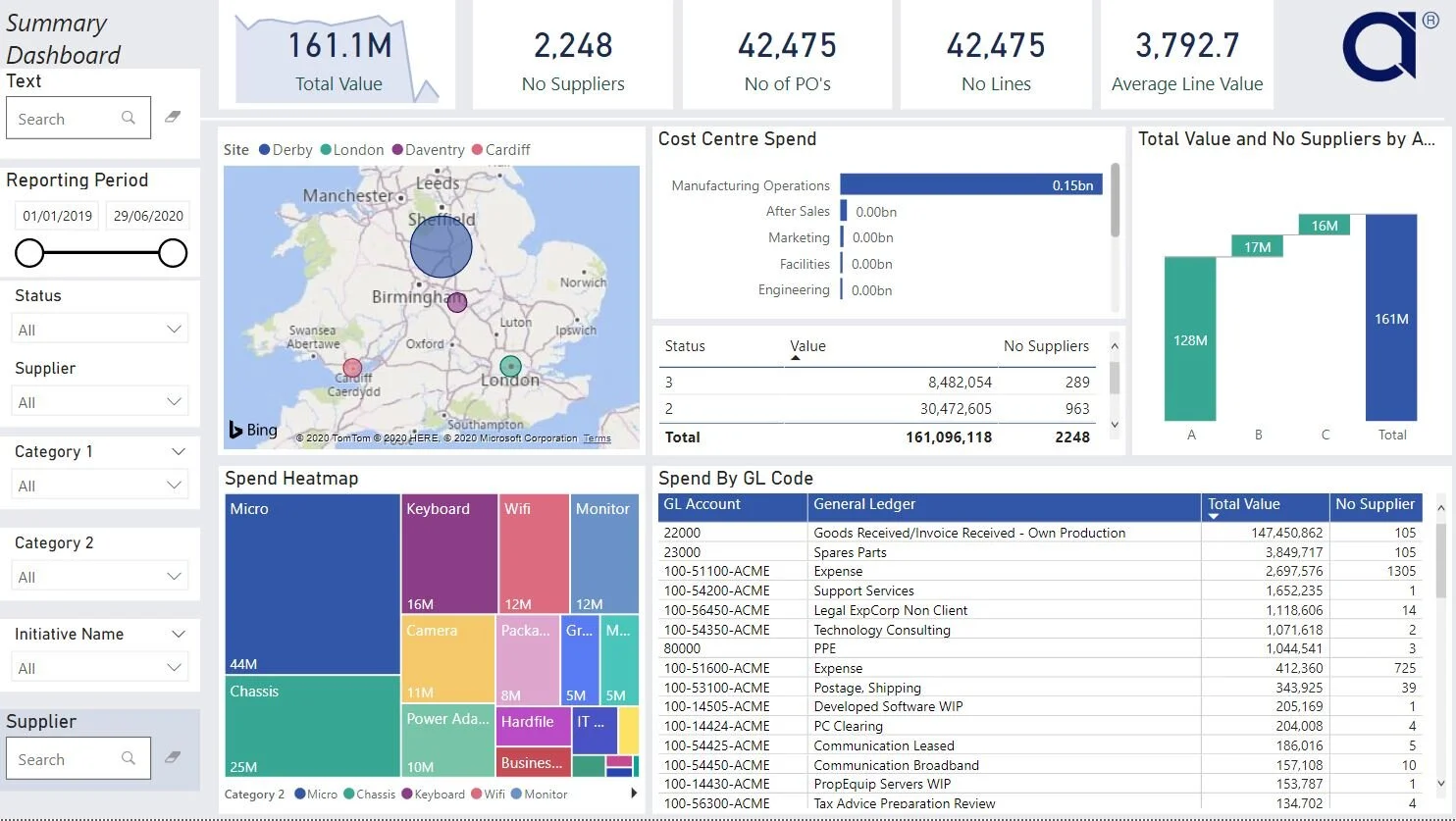
Important Disclaimers:
Technology Evolution Notice: The information about Airbase and other financial technology tools presented in this article reflects our thorough analysis as of 2025. Given the rapid pace of technology evolution, features, pricing, and security protocols may change after publication. I recommend visiting the official Airbase website for the most current information.
Professional Consultation Recommendation: For financial software applications with significant professional or compliance implications, I always recommend consulting with qualified professionals. An expert can assess your specific requirements and risk tolerance. This overview is designed to provide a comprehensive understanding, not to replace professional advice.
Testing Methodology Transparency: My analysis is based on hands-on testing simulations, official documentation review, and industry best practices current at the time of publication. Individual results may vary based on specific use cases and implementation approaches.
Comprehensive FAQs Section
Is Airbase a replacement for Bill.com?
Yes, for most companies. Airbase includes a comprehensive Accounts Payable and bill payment module designed to replace the functionality of Bill.com. The key difference is that Airbase integrates bill payments with corporate cards and expense reimbursements into one system.
Can Airbase handle international payments?
Yes. Airbase supports international payments to a wide range of countries. Its current capabilities include local currency card issuance in certain regions, but companies with significant international operations should verify capabilities for their specific countries directly with Airbase.
How does Airbase make money if it offers cashback on card spend?
Airbase earns a portion of the interchange fees that merchants pay when a corporate card is used. This revenue model allows the company to offer its software at a competitive price while also providing a cash-back incentive to customers.
Is Airbase secure enough for a pre-IPO company?
Yes, it is designed for that level of scrutiny. The platform's SOC 1 and SOC 2 compliance, robust audit trails, and pre-spend controls are critical features for companies preparing for an IPO and needing to demonstrate SOX compliance. My advice is to engage your auditors early and have them review the platform's capabilities and SOC reports.
What is the biggest challenge when implementing Airbase?
The biggest challenge is typically change management. Moving a company's culture from a reactive “spend-then-report” model to a proactive “request-and-approve-first” model requires clear communication and executive support. The technical setup is straightforward with their support, but the cultural shift needs careful planning.
How long does it take to implement Airbase?
For a mid-sized company with a standard ERP integration like NetSuite or QuickBooks, the typical implementation time is between 4 to 8 weeks. This includes technical setup, workflow configuration, and employee training.
Does Airbase integrate with HRIS systems like BambooHR?
Yes. Airbase integrates with popular HRIS platforms, such as BambooHR and Gusto. This integration automates the employee lifecycle, automatically creating user accounts for new hires and deactivating them for departing employees, which is a key internal control.
What's the difference between Airbase and Ramp?
The main difference is their founding philosophy. Airbase was built as an all-in-one platform from the start, integrating AP, cards, and expenses. Ramp began as a corporate card and expanded into bill pay, so its AP module is less mature. Airbase generally offers more complex approval workflows and deeper ERP integrations.
Can I create complex, multi-step approval workflows?
Yes, this is one of its core strengths. You can create approval chains based on almost any data field from your ERP, including department, subsidiary, vendor, and custom fields. This allows for highly granular control over spending.
Does Airbase have a mobile app?
Yes, it has a highly-rated mobile app for both iOS and Android. Employees can use the app to request funds, submit receipts by taking a photo, and approve transactions on the go.
Is Airbase suitable for a company with fewer than 50 employees?
It is generally not the best fit. Airbase is designed for the complexity of mid-market companies (200-5,000 employees). A company with fewer than 50 employees may find the platform to be more powerful and complex than what they currently need.
How does the NetSuite integration actually work?
The integration uses a bi-directional API sync. This means transaction data, vendors, and GL accounts flow automatically between Airbase and NetSuite in near real-time. Bills are coded in Airbase and then pushed to NetSuite as vendor bills with all the correct data, eliminating manual entry.
What kind of customer support does Airbase offer?
Airbase offers dedicated implementation managers for new customers. After launch, they provide ongoing support through a dedicated customer success manager and an in-app chat function, with different service levels depending on the pricing tier.
Can Airbase prevent duplicate invoices from being paid?
Yes. The system automatically flags potential duplicate invoices based on attributes like invoice number, vendor, and amount. This prevents costly duplicate payments from being processed.
How are virtual cards different from regular corporate cards?
Virtual cards are software-defined digital cards with strict, pre-set controls. Unlike a physical card with a high limit, a virtual card can be locked to a single vendor, a specific budget, and an expiration date. This dramatically reduces the risk of fraud and overspending.
For additional questions and detailed answers, visit our comprehensive Airbase FAQs section where we address common implementation concerns and provide expert guidance.
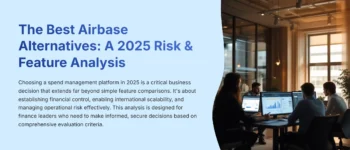




Leave a Reply